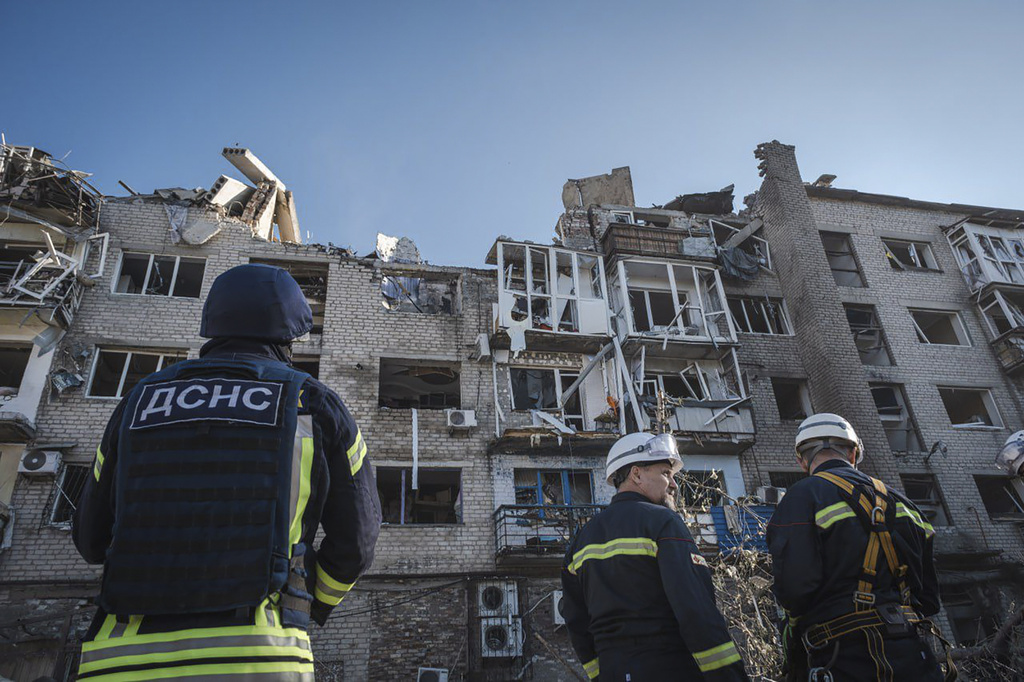A Deadly Night of Bombardment
In the early hours of Sunday, September 7, 2025, the skies over Ukraine erupted with an intensity not witnessed since the war began. Russia launched its largest aerial assault of the conflict, deploying more than 800 drones in combination with cruise and ballistic missiles aimed at multiple Ukrainian cities. Kyiv, the country’s capital, bore the brunt of the onslaught.
The Cabinet of Ministers building in the Pecherskyi District, home to Ukraine’s central government offices, was struck directly, igniting a fire that raged through parts of the structure. This marked the first time since the war began that a central government facility was targeted in such a direct manner. For residents of Kyiv, it was not only another night of sirens, explosions, and fear, but also a visceral reminder of the conflict’s unrelenting escalation.
Ukraine’s air defense systems worked at full capacity. Officials reported intercepting between 747 and 751 drones, along with several missiles, before they could reach their intended targets. Still, the defense was not impenetrable. At least three to four civilians were killed, among them a mother and her infant child. Between 18 and 44 others were injured, many suffering shrapnel wounds and burns. Apartment complexes, vehicles, and infrastructure were also damaged, underscoring the devastating impact of such a large-scale strike.
“This is terror, nothing less,” one Kyiv resident told local reporters as emergency crews sifted through debris. “We survived the night, but the fear will not leave us. No one feels safe anymore.”
International media outlets, including The Guardian, AP News, The Times of India, and The Washington Post, framed the assault as a grim milestone, a sign that Moscow is willing to escalate regardless of humanitarian cost.
A Message of Escalation
Beyond the physical destruction, the attack carried a symbolic weight. Striking the Cabinet of Ministers building was interpreted by Ukrainian leaders as an attempt to erode public morale and undermine the sense of state security.
President Volodymyr Zelenskyy denounced the assault as “a deliberate act of cruelty,” arguing that it revealed Russia’s complete disregard for peace efforts. Political analysts echoed this sentiment, warning that Moscow’s choice of targets represented a clear rejection of negotiation or compromise.
“This is not just about military objectives,” one Kyiv-based security analyst explained. “By hitting a central government site, Russia is sending a political message: they intend to fight until Ukraine’s institutions themselves are destabilized.”
International reactions came swiftly. U.S. President Donald Trump announced his administration would seek tougher sanctions against Russia, with a particular focus on its vital oil and gas sectors. European Union leaders and officials in the United Kingdom quickly echoed those calls, urging coordinated action to choke off the revenues sustaining Russia’s war machine.
For Kyiv, the message was clear: the war was entering a more dangerous phase where government institutions, civilian resilience, and international resolve would all be tested.
Kyiv’s Strategic Countermove
Ukraine did not wait long to respond. Within hours of the assault, Ukrainian forces launched counterstrikes targeting Russia’s energy infrastructure, specifically the Druzhba oil pipeline in the Bryansk region. The Druzhba pipeline is one of Russia’s most important energy arteries, supplying crude oil to several European countries, including Hungary and Slovakia.
Commander Robert Brovdi, a senior Ukrainian military official, confirmed that the strikes had caused “comprehensive fire damage” to critical sections of the pipeline. Satellite imagery later showed thick black smoke rising from Bryansk, confirming the scale of the disruption.
The choice of target was no coincidence. By striking energy infrastructure, Kyiv sought to undercut Russia’s war economy while signaling to both Moscow and its international allies that Ukraine retains the ability to wage economic as well as military warfare.
Zelenskyy’s message was clear: the battlefield now extends beyond the front lines into the logistical and financial arteries of the conflict. “Russia wages war not only with missiles and drones, but with oil, gas, and money,” he said in a televised address. “We must cut off the weapons that fuel their aggression.”
Why This Matters: The Broader Implications
The September 7 assault on Kyiv and the subsequent Ukrainian retaliation mark a turning point in the conflict, one that carries profound implications for the war’s trajectory and the prospects of peace.
-
An Unprecedented Escalation
The sheer scale of Russia’s attack, deploying over 800 drones in a single night, was unprecedented. Analysts describe it as a demonstration of Moscow’s evolving tactics, designed to overwhelm Ukrainian defenses through sheer volume. Even with the majority of drones intercepted, the attack succeeded in stretching Ukraine’s air defense network to its limits.
Equally significant was the decision to target the Cabinet of Ministers building. Unlike military bases or power plants, government institutions are symbolic representations of sovereignty. Striking them risks crossing into political assassination by proxy, as civilian leaders work and convene within these spaces.
This shift suggests that Russia is willing to take greater risks, even if it means drawing harsher condemnation from the international community.
-
The Human Cost and Infrastructure Damage
Every escalation has a human price. In Kyiv, families were torn apart, homes were destroyed, and thousands spent another sleepless night in bomb shelters. Hospitals across the city reported an influx of patients suffering trauma-related injuries, adding strain to a health care system already burdened by years of war.
Meanwhile, infrastructure damage has broader economic and psychological consequences. When government buildings, schools, and utilities are struck, public morale is shaken. Residents begin to question not just their personal safety but also the stability of their country’s institutions.
-
Mounting International Pushback
For Western allies, the September 7 assault provided renewed justification for increasing pressure on Russia. Sanctions, already extensive, may soon target additional sectors of Russia’s economy, including insurance for oil shipments and access to global banking networks.
While President Trump’s proposed sanctions drew mixed reactions in Washington, where lawmakers remain divided on how aggressively to confront Moscow, the European Union signaled broad support for coordinated measures. The United Kingdom likewise pressed for stronger punitive action, with Foreign Secretary announcements emphasizing the need to “close the remaining gaps in Russia’s economic defenses.”
The international response highlights how Russia’s escalation, rather than weakening Western resolve, may instead strengthen it.
-
Kyiv’s Blended Military Strategy
Ukraine’s retaliation against the Druzhba pipeline highlights a new phase in its military strategy. Rather than focusing solely on defensive operations, Kyiv is leveraging offensive strikes that disrupt Russia’s economic lifelines.
Targeting oil infrastructure is not just a military tactic but also a diplomatic maneuver. It forces Russia’s partners, particularly in Europe, to confront the reality that Moscow’s war is jeopardizing their own energy security. This in turn increases pressure on European governments to step up military and financial aid to Ukraine.
By blending traditional warfare with economic disruption, Kyiv is expanding the scope of its resistance in ways that may reshape the conflict’s long-term dynamics.
-
Diplomatic Deadlock
Perhaps the most sobering implication of the September 7 events is the deepening diplomatic deadlock. Despite repeated calls from international mediators for renewed peace talks, both Moscow and Kyiv appear more entrenched than ever.
For Russia, the direct strike on Kyiv’s government core represents a declaration that it sees no incentive in compromise. For Ukraine, the retaliatory strikes on Russian energy infrastructure reflect a determination to escalate until meaningful concessions are achieved.
The cycle of attack and counterattack leaves little room for negotiation. As one European diplomat observed, “Every drone that flies, every missile that falls, closes the door to peace a little further.”
Looking Ahead
The largest aerial assault on Kyiv since the war began is more than just a tragic episode; it is a harbinger of the conflict’s future trajectory. Russia’s willingness to escalate, even at the cost of international backlash, suggests the war is entering an even more destructive phase. Ukraine’s countermeasures, targeting energy infrastructure, reveal a strategy designed to impose costs not just on Moscow’s military but on its economy and political standing.
For civilians in Kyiv and beyond, the consequences are immediate: more nights in bomb shelters, more uncertainty about the future, and more grief for lost lives. For global leaders, the challenge is to respond with unity and resolve while avoiding a spiral that could widen the conflict beyond Ukraine’s borders.
The September 7 bombardment may ultimately be remembered as a turning point. It crystallized the war’s dual nature: a struggle for territory and sovereignty on the battlefield, and a battle for economic and political survival in the corridors of power.
As winter approaches and energy demands rise, the fight over pipelines, sanctions, and resilience will matter as much as the clashes on the front lines. What remains uncertain is whether the world is witnessing the war’s climax or merely its next phase.

